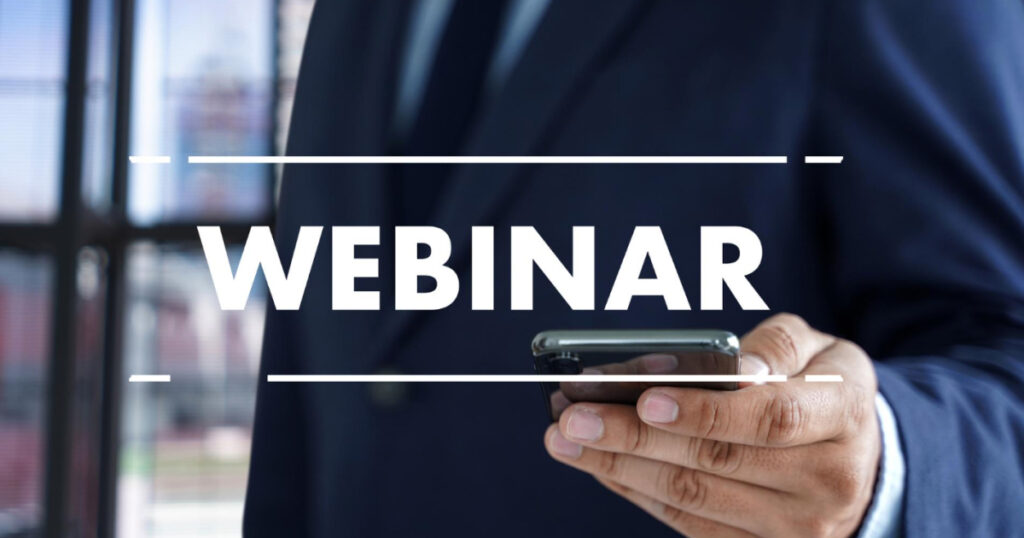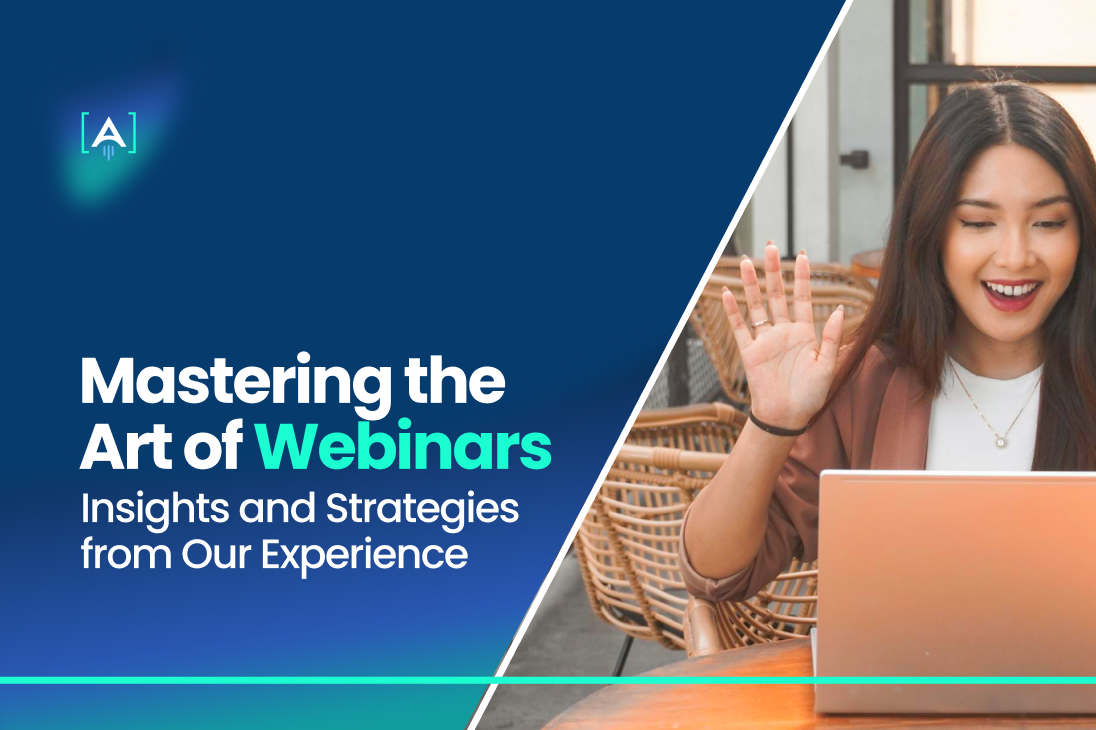Download Our Guide to Master the Art of Webinars
Do you think about hosting webinars? You’re onto something big!
According to 89% of survey participants, hosting webinars generates qualified leads more effectively than other channels.
Webinars are a powerful tool to connect with a broad audience, transcending geographical boundaries.
Drawing from our own successful experiences, this blog post serves as your comprehensive guide to mastering growth webinars.
We’ll share webinar marketing insights and strategies honed through our journey – from meticulously planning to effectively promoting your webinars.
What is a Webinar?
What exactly is a webinar? Think of it as a seminar, but it is happening online.
A host or hosts choose the webinar topic and start the event on a webinar platform.
Webinar attendees can actively participate in polls, surveys, and discussions and ask questions.
Why Host a Webinar?

Businesses of all sizes seek new and innovative ways to connect with their target audience.
Here are a few reasons why you should consider leveraging webinar marketing as part of your strategy:
Global Connection, Local Comfort: No more geographic limits! Webinars break down barriers, allowing you to connect and engage with people worldwide.
Interactive Engagement: Webinars turn your audience into active participants – they can ask questions, chat with others, and engage with interactive features, creating a dynamic experience.
Generate Leads: Webinars are a powerful lead generation tool. By offering a free webinar in return for contact information, you can collect valuable leads that you can use to nurture your sales pipeline.
Promote a product: Webinars provide a platform to directly highlight your product’s value to your audience. Incorporating product led growth marketing into your webinar strategy allows you to demonstrate how your product solves real problems, attracting and retaining customers more effectively.
Nurture Existing Leads: Webinars are for more than just generating new leads. They can also nurture existing leads and move them closer to a sale. By providing educational and informative content, you can give more details about your products or services and make informed decisions.
Get Feedback: Webinars are a great platform for asking questions and collecting feedback. This provides valuable insights into your target market, helping you refine and enhance your marketing efforts.
Repurpose Content. You can repurpose the webinar content into blog posts, articles, and social media content.
Boost Brand Awareness: Webinars are a great way to get your brand in front of new eyes. By delivering valuable and informative content, you can position yourself as an expert in your field and build trust with potential customers.
Save Money: Webinars are a cost-effective way to reach a large audience. Compared to traditional events, webinars require less planning, preparation, and overhead.
Webinar Marketing as a Lead Generation Tool

One of the powerhouse roles of webinar marketing is lead generation.
Webinars are a dynamic tool for cultivating meaningful connections with your audience and turning them into valuable leads.
Educate and Capture Interest
Webinars provide a unique opportunity to educate your audience.
As you share valuable insights and knowledge, participants become engaged learners.
This engagement becomes a gateway to capturing their interest and, subsequently, their contact information.
Offering Value in Exchange for Information
The exchange is simple yet powerful.
Attendees get access to your expertise, industry insights, or exclusive content, and you gain access to their contact details.
This information becomes gold for your lead generation strategy, allowing you to connect with a genuinely interested audience.
Building Trust Through Expertise
As you present your expertise during a webinar, you impart information and build trust.
Potential customers appreciate firsthand knowledge, and by positioning yourself as an authority in your field, you instill confidence in your brand.
Interactive Engagement for Data Collection
Webinars offer interactive features like Q&A sessions and polls.
Leverage these tools to engage your audience and collect valuable data.
Understand their pain points, preferences, and expectations, enriching your lead profiles for more targeted follow-ups.
Nurturing Leads Post-Webinar
The webinar marketing isn’t the end; it’s the beginning. Use the information gathered to nurture your leads effectively.
Follow up with additional resources, personalized content, or exclusive offers, keeping the momentum going post-event.
Webinars as a Powerful Tool for Each Stage of the Sales Funnel

The sales funnel is the journey potential customers take before becoming loyal ones.
But did you know webinars can be your secret weapon at each stage of that journey?
Let’s explore how webinar marketing makes it possible.
Stage 1: Awareness
Think of it as an invitation.
Webinars are like organizing an online event, inviting people interested in your field.
You share valuable information and expertise, making them aware of your brand and what you offer.
Stage 2: Acquisition
Webinars allow you to dive deeper, addressing your audience’s specific needs and challenges.
You showcase your capabilities and establish yourself as a trusted advisor.
It’s a chance for potential customers to see if your solutions are the right fit for them, allowing them to compare and evaluate before making a decision.
Stage 3: Activation
Webinars can provide the final piece of the puzzle, answering any remaining questions and addressing concerns.
You offer a compelling reason to choose your solution.
It leaves a positive impression, prompting them to take action and become your customer.
Stage 4: Customer Retention
Happy customers are repeat customers.
Webinars keep your existing customers engaged and coming back for more.
You build strong relationships and ensure long-term loyalty by providing ongoing value through informative and engaging webinars.
Stage 5: Revenue Growth
Webinars are like a budget magnet, attracting new customers and driving up your revenue.
The more people you reach and convert, your business grows and thrives.
Stage 6: Referral
Picture a scenario where your customers are satisfied and enthusiastic about your product or service.
In this stage, leveraging their positive experiences is key.
This referral process helps to build a trusted community around your offerings, driving new customer engagement based on the credibility and trust established by existing satisfied customers.
Download Our Guide to Master the Art of Webinars
A Step-by-Step Guide to Hosting a Successful Webinar

But wait, how do you actually do webinar marketing?
Let’s unravel the secrets to hosting a successful webinar, from choosing the perfect topic to keeping the conversation going.
8 Weeks Before the Webinar: Setting the Stage
Select your webinar’s topic(s): Pin down the subject matter, ensuring it aligns with your audience’s interests and needs.
Select your presenter(s): Identify experts with knowledge and virtual webinar presentation skills to bring it to life.
Determine your goals for the webinar: Set clear objectives – brand promotion, education, or lead generation. Choose between a live or on-demand format.
Identify your target audience: Define a specific and tailored audience to shape your content effectively.
Create a webinar playbook: Outline the webinar format, structure, content flow, and roles, ensuring everyone’s on the same page. Explore potential sponsors or partners.
7 Weeks Before the Webinar: Planning the Logistics
Select a date and time for your webinar: Consider audience availability and choose a time that accommodates different time zones.
Delegate tasks between presenter, host, and event services team: Clearly define responsibilities and seek necessary approvals.
Determine a theme for your webinar: Set the tone, aligning with educational, informational, or entertaining themes.
Determine the length of the program: Outline the duration, breaks, and interactive elements to keep attendees engaged.
Determine how you want attendees to register for the webinar: Use the webinar platform for seamless registration. Create a strategy for additional resources and lead magnets.
6 Weeks Before the Webinar: Promoting Your Webinar
Compile a list of prospective attendees: Specify your target market for promotional efforts.
Create a webinar promotional plan: Develop a content marketing calendar and plan email campaigns and social media posts.
Prepare a marketing promo kit: Equip sponsors, presenters, and hosts with social media graphics and suggested posts.
Check technical requirements: Ensure presenters have the necessary equipment and explore post-webinar engagement options.
2 Weeks Before the Webinar: Finalizing Preparations
Start working on the presentation deck and design: Craft visually appealing slides with a smooth flow.
Verify that all presenters have shared their materials: Ensure all materials are in and consider interactive elements like polls.
1 Week Before: Ensuring Readiness
Monitor and analyze promotions: Analyze registration sources and revise marketing plans accordingly.
Finalize the script for webinar speakers: Ensure polished and professional presentations.
Create webinar lead magnets: Develop incentives to maintain participant engagement.
Prepare your post-webinar evaluations and debrief: Create feedback questions and schedule a debrief session for the team.
Day Of: Executing a Flawless Webinar
Send a final email invitation: Leverage last-minute registrations with a final invitation.
Join the webinar room: Ensure presenters are in the webinar room 20 minutes prior.
Check your recording status: Verify the event is being recorded for future use.
Live support: Have moderators handle issues for a smooth presentation.
1 Day After the Webinar: Evaluating and Following Up
Analyze your webinar statistics: Review webinar analytics, attendance, and engagement metrics.
Review your webinar recording: Check the recording for potential edits or repurposing.
Send follow-up communications: Thank attendees and registrants, providing On-Demand links.
2 Days After the Webinar: Extending the Impact
Follow Up: Send a thank-you email with On-Demand links. Create an email newsletter strategy for continued engagement for your future webinars.
Answer your Q&A in a blog: Address questions asked during the webinar in a follow-up blog post.
Keep the conversation going: Engage in post-webinar discussions on social media.
Repurpose: Leverage On-Demand viewings and replays for increased ROI.
Conduct a webinar debrief session: Evaluate the success of lead magnets and adjust future strategies.
Crafting Engaging Content: Grab Your Audience’s Attention

To ensure a comprehensive reach, you must leverage diverse growth marketing channels like content syndication, influencer partnerships, and targeted ads to promote your webinar effectively.
However, in the webinar world, content rules.
Content marketing growth plays a pivotal role in drawing and retaining an engaged audience. By delivering valuable and relevant information, you attract more participants and build lasting relationships that drive further interest in your webinars.
So, make the webinar content informative and captivating.
Start strong, keep it organized, use visuals, and add interactive elements.
Engage with stories, focus on value, and respect your audience’s time. A compelling webinar is a journey, not a lecture.
While webinars are excellent for reaching a broad audience, combining them with hyperlocal marketing strategies can significantly enhance engagement by tailoring the content to resonate with specific communities or regions.
Building Valuable Resources: Enhancing the Webinar Experience
A successful webinar event continues even after the live session concludes.
It extends into the resources you provide. Elevate the webinar experience by offering valuable resources:
- Downloadable Materials: Provide additional materials for download – PDFs, guides, or checklists. These resources are handy references for attendees.
- Relevant Links: Share relevant links during the webinar and compile them in a post-webinar resource kit. This makes it easy for attendees to explore further.
- Post-Event Recording: Make the webinar recording available. It’s not just for those who missed the live session – attendees often appreciate revisiting key points.
- Exclusive Access: Offer attendees exclusive access to additional content or webinars. This creates a sense of privilege and encourages continued engagement.
- Lead Magnets: Use resources as lead magnets. Ask attendees to provide feedback or complete a survey in exchange for access to exclusive materials.
- Discussion Forums: Create a post-webinar discussion forum. It’s a space for attendees to connect, share insights, and ask lingering questions.
- Engagement Emails: Follow up with engagement-focused emails. Share relevant resources, highlight key takeaways, and keep the conversation going.
Webinar Marketing Strategies: Spreading the Word Effectively

You’ve got your webinar content ready; let’s shout it from the virtual rooftops.
Here’s how to create buzz and extend your reach:
- Leveraging Social Media for Maximum Reach: Share sneak peeks, craft engaging posts, and use hashtags that resonate with your audience. Maximize your social platforms to create a buzz.
- Tapping into Cold Outreach: Break the ice. Reach out directly to potential attendees with personalized invitations. Let them know why your webinar is a must-attend, focusing on the value they’ll gain.
- Maximizing Newsletter Impact: Make your newsletter work for you. Drop hints about your webinar, add compelling snippets, and provide easy registration links. Make subscribing and signing up easy.
- Investing in Paid Advertising: Sometimes, a small investment pays off big. Consider paid ads on platforms your audience frequents. It ensures your webinar shines in the crowded online space.
Partnering with a growth marketing agency can amplify your webinar marketing efforts, ensuring your events reach a broader audience and generate substantial engagement.
Webinar Structure: A Blueprint for Engaging Sessions

A well-structured webinar ensures your audience stays hooked from start to finish.
Here’s a breakdown of each section:
Opening (5 minutes): Welcome and Set the Stage
- Welcome and Introduction: Greet your audience warmly. Introduce yourself, set a friendly tone, and express gratitude for their presence.
- Brief Agenda Overview: Give a snapshot of what’s coming. A quick agenda overview sets expectations and keeps attendees tuned in.
Webinar Topic Discussion (30 minutes)
- Engage with Valuable Content: Get to the heart of your topic. Share insights, facts, and tips your audience finds valuable and relevant.
- Visuals and Real-world Examples: Paint a vivid picture. Use visuals, real-world examples, and relatable scenarios to drive your points home.
- Encourage Participation: It’s not a monologue. Use polls and questions to involve your audience actively. Their engagement enhances the webinar experience.
Product/Service Demo (15 minutes)
- Highlight Key Features and Benefits: Showcase what you’re offering. Highlight the key features and emphasize the benefits your audience stands to gain.
- Demonstrate Problem Solving: Demonstrate how your product or service solves problems, making it a must-have for your audience.
- Address Concerns: Anticipate questions. Address potential pain points or concerns your audience might have. Transparency builds trust.
Q&A Session (15 minutes): Interact and Clarify Doubts
- Invite Questions: Invite participants to ask questions. Their queries guide the session to address their specific needs.
- Address Concerns and Queries: Be responsive. Address common concerns and queries, creating a connection with your audience.
- Encourage Interaction: It’s a conversation, not a lecture – foster audience interaction. A lively Q&A session adds depth to your webinar.
Conclusion and Next Moves (5 minutes): Wrapping Up the Session
- Summarize Key Takeaways: Reinforce the main points. Summarize critical takeaways to leave a lasting impression.
- Thank the Audience: Express gratitude. Thank your audience for their time and participation. A little appreciation goes a long way.
- Provide Post-webinar Information: Keep the connection alive. Share information on post-webinar resources, offers, or ways to stay engaged.
Using the Right Webinar Software: A Smooth Ride for Your Audience

Your webinar’s success depends on the technology you choose, too.
Here’s why it matters and a quick list of reliable webinar software options.
Seamless Interaction: Your chosen technology should allow seamless interaction. Look for features like live chat, Q&A sessions, and polls.
User-Friendly Interface: Keep it simple. Your audience shouldn’t feel like they need a tech degree to join. Look for platforms with an intuitive, user-friendly interface.
Reliable Streaming: Imagine the frustration of a glitchy webinar. Your chosen technology should offer reliable streaming, ensuring a smooth experience for your audience.
Analytics and Insights: Choose a platform that provides analytics and insights. Understand who attended, how long they stayed, and what engaged them the most. This data is gold for refining future webinars.
Integration Capabilities: Choose a platform to seamlessly integrate with your other tools – from email marketing to customer relationship management (CRM).
Recording and Repurposing: Ensure your technology allows easy recording and, ideally, provides options for repurposing. A recorded webinar becomes a valuable asset for future promotions or additional content.
Security Measures: Choose a platform with strong security measures to protect you and your audience.
Webinar Software Options
Zoom: Widely used for its ease of use and interactive features.
eWebinar: User-friendly platform with automated webinar capabilities.
Demio: Known for its simplicity and engagement-focused features.
Embrace the Power of Webinars

In the grand finale of our webinar journey, remember this: mastering webinars is a blend of meticulous planning, engaging content, and strategic promotion.
Armed with our insights, go forth, host, and conquer. May your webinars be engaging, your audience captivated, and your success unparalleled.

